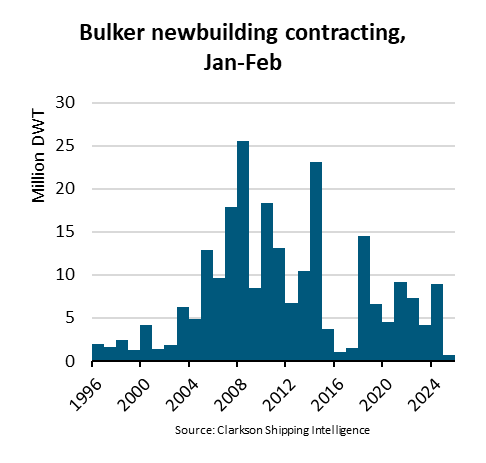Shipping companies are piloting an innovative cloud-based solution for weather-optimized voyage routing launched by OrbitMI that allows routes to be plotted automatically based on cost, time and fuel consumption as new CII regulations raise the pressure to cut CO2 emissions.
The Orbit Weather+ digital solution, powered by DTN® marine weather APIs, is now being implemented fleet-wide by Stena Bulk, with multiple pilots ongoing at other companies, according to US-based vessel performance management (VPM) software company OrbitMI. It has already been used to route tankers and dry bulk vessels hundreds of times since its launch last summer.
The automated solution can find the smartest, safest and most fuel-efficient route by using AI-based machine learning to analyze constantly updated weather data fed into the Orbit VPM system through DTN APIs.
This makes it possible for vessel operators to generate unlimited ‘what if’ scenarios based on a range of business parameters - including bunker usage and cost, ETA, CO2 emissions, CII rating and possible hazards - to determine the optimal route, marking a transformational shift from the traditional method of weather routing.
Digital solutions for efficiencies
Implementation of Orbit Weather+ in the shipping industry coincides with the enforcement from 1 January this year of the IMO’s Carbon Intensity Indicator (CII) whereby vessels over 5000 tonnes will be rated from A to E based on their emissions relative to cargo carrying capacity and distance travelled, with a requirement for progressive improvements in energy efficiency towards 2030.
A vessel’s CII rating, as well as its EEXI (Energy Efficiency Existing Ship Index) score that also comes into play this year, will become key commercial criteria for cargo owners and charterers in business decision-making amid an increasing focus on the sustainability of the overall supply chain.
“Digital transformation is being driven by external pressures such as CII and EEXI regulations, as well as the advancement of the EU’s Emissions Trading System and carbon pricing, which will force charterers, ship owners and operators to adopt new solutions,” said OrbitMI’s chief marketing officer David Levy.
Weather-optimized routing is one of the digital tools available to achieve operational efficiencies to reduce fuel consumption from the existing fleet that will be necessary to meet the IMO target to reduce the carbon intensity of shipping by 40% within 2030, according to Levy.
Climate change impacts
At a recent online demonstration of Orbit Weather+, DTN vice president global weather intelligence Renny Vandewege said: “Timely weather data continues to be a key factor, when combined with other maritime data parameters, as part of the analytics required by global shipping professionals to operate efficiently, reduce fuel burn and CO2 emissions, and keep crews and cargo safe.”
He highlighted the weather impacts of climate change such as rising sea levels, increasing wave heights, rougher sea conditions and a growing incidence of tropical storms that can cause voyage delays, which lead to less operational efficiency and higher emissions, as well as pose greater risks to people, assets and cargoes.
DTN strategic product manager Jarco van der Brink commented that by harnessing multiple DTN APIs into a dynamic dashboard, Orbit Weather+ is able to offer integrated access to the insights needed for better vessel-based decision making. Orbit Weather+ can surface insights to guide operational efficiency, environmental impact, safety and myriad other use cases such as improved CII rating, reduced fuel consumption and avoiding container loss.
Transparency in decision-making
The plug-and-play solution, which requires no software or hardware installation, is always working in the background by continually updating and analyzing weather data to generate optimized routes based on current conditions in a matter of minutes.
This is in contrast to the traditional method of weather routing that typically entails time-consuming emails back and forth with a shore-based consultant and route updates only on a daily basis.
However, OrbitMI’s vice president engineering Slavisa Djokic emphasised the system does not replace a shore-based weather consultant and the vessel captain remains the final decision-maker on which route to follow. “Rather, this is creating transparency for charterers and vessel operators in the weather-routing workflow by giving them more optionality and capabilities in voyage decision-making,” he explained.
Cost benefits
Orbit Weather+ allows an unlimited number of alternative routes to be generated at no extra cost due to a per-active-vessel pricing model, greatly reducing the cost per route versus the traditional method that entails additional fees for new route requests.
This means it can be applied to any number of routes for voyages of any distance across an entire fleet, rather than only long-haul routes due to cost constraints with traditional routing, to realise additional substantial cost savings with fuel reductions on short-haul routes.
Consequently, operators that have implemented the solution have seen as much as a thirtyfold return on investment, according to Levy, who said future releases of the software will result in further optimizations for earnings, CII and other parameters.
The opinions expressed herein are the author's and not necessarily those of The Xinde Marine News.
Please Contact Us at:
media@xindemarine.com


 Ningbo Containerized Freight Index Weekly Commentar
Ningbo Containerized Freight Index Weekly Commentar  Ningbo Containerized Freight Index Weekly Commentar
Ningbo Containerized Freight Index Weekly Commentar  Ningbo Containerized Freight Index Weekly Commentar
Ningbo Containerized Freight Index Weekly Commentar  BIMCO Shipping Number of the Week: Bulker newbuildi
BIMCO Shipping Number of the Week: Bulker newbuildi  Ningbo Containerized Freight Index Weekly Commentar
Ningbo Containerized Freight Index Weekly Commentar  Ningbo Containerized Freight Index Weekly Commentar
Ningbo Containerized Freight Index Weekly Commentar